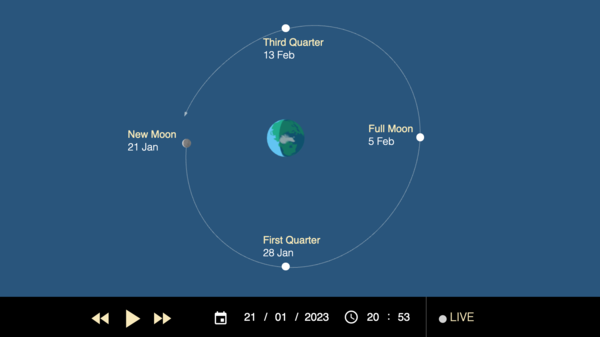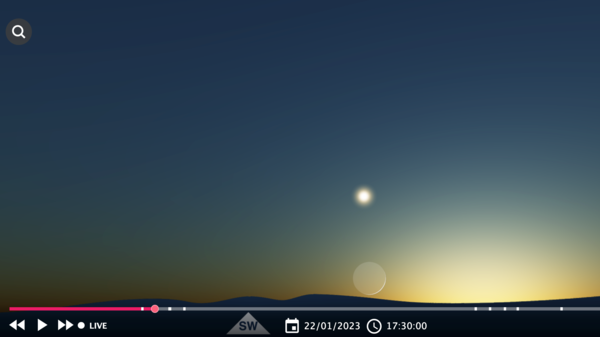January 21, 2023: Closest New Moon Since the Middle Ages
This Saturday’s New Moon will be the closest New Moon to Earth in a period of 1337 years.

The New Moon of January 2023 coincides with the point in the Moon’s orbit where it is closest to Earth.
©timeanddate
A Remarkably Close New Moon
According to our calculations, on January 21, 2023, the New Moon will be at its closest distance to Earth for the last 992 years.
The next time the New Moon is this close to Earth will be 345 years from now, making this the closest New Moon in 1337 years.
Moon phases visualized—where is the Moon?
Earth-Moon Distance Always Changing
The Moon’s orbit around Earth is not a perfect circle. Instead, it has an elliptical shape, like a slightly stretched circle. This means the distance between the Moon and Earth changes over the course of a month.
The point on the Moon’s orbit that is closest to Earth is called perigee; the farthest point is called apogee.
Extreme Near and Far Distances
If perigee or apogee coincides with a New Moon or Full Moon—when the Earth, Moon, and Sun are in alignment—the Moon’s closest and farthest distances become more extreme.
This leads to the phenomena of Supermoons and Micromoons, where the Moon is particularly near or far away.
The most extreme Earth-Moon distances of all occur when Earth is near its closest point to the Sun, which is called perihelion. Currently, perihelion falls around the beginning of January.
Closest New Moons of the Current Era
We looked into the closest Earth-Moon distances at New Moon over a 2000-year period, and found three New Moons where the distance was less than 356,570 km (221,562 miles).
Our calculations used the best available figures for the Moon’s position over long periods of time. This is a set of data called DE431, which was produced by the Jet Propulsion Laboratory at the California Institute of Technology.
The Three Closest New Moons, 1000 CE to 3000 CE
| Year | Date | Earth-Moon Distance |
|---|---|---|
| 1030 | December 3 | 356,562 km (221,557 miles) |
| 2023 | January 21 | 356,568 km (221,561 miles) |
| 2368 | January 20 | 356,559 km (221,555 miles) |
Sources: JPL Ephemeris DE431, timeanddate.com
It should be noted that, according to this data, there is only a few kilometers’ difference between these distances. It can also be seen that the three dates fall close to perihelion (around December and January).
As a comparison, the farthest Earth-Moon distance is typically around 405,000 km (252,000 miles).
What Does This Mean for Us?
So this will be the closest New Moon—and also, therefore, the largest—since the 11th century.
In practical terms, we won’t be able to see anything, because the New Moon is known as the invisible phase: it’s where the Moon disappears from view for a few days.
Supermoons and Micromoons do have a small effect on tides. And, of course, anything to do with the Moon has the potential to fill us with wonder and curiosity.
The Next Day: Two Planets Almost Touch in the Sky
In fact, this will be a weekend of astronomical close encounters.
On Sunday, January 22, Venus will appear to pass within 0.34° of Saturn. This is less than the width of a little finger held at arm’s length.

Venus and Saturn appear as a single star in this view from our Night Sky Map for New York City at 17:30 (5:30 pm) local time on January 22. Saturn will be much fainter than bright Venus. This image also includes the super-thin crescent of a one-day-old Moon.
©timeanddate
Find Venus and Saturn on our Night Sky Map
In a session at last year’s Europlanet Science Congress in Granada, Spain, timeanddate highlighted this event as one of seven notable close approaches of planets between now and 2040.